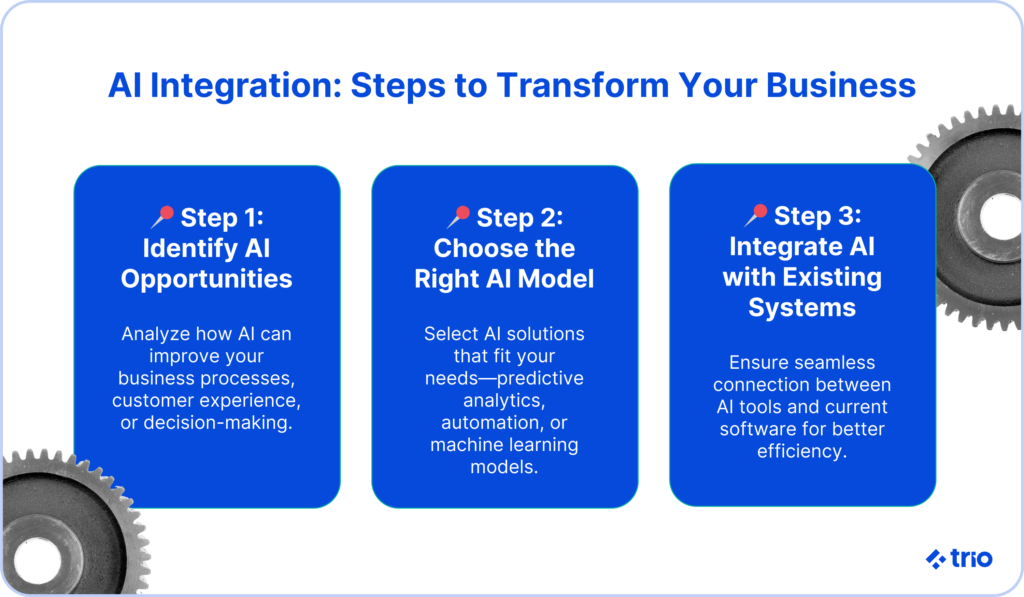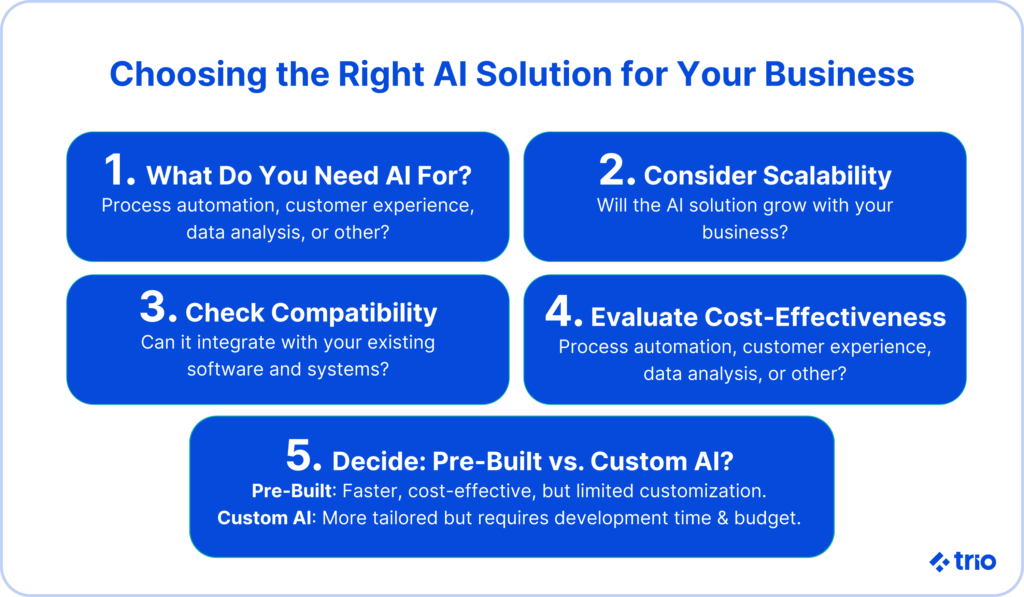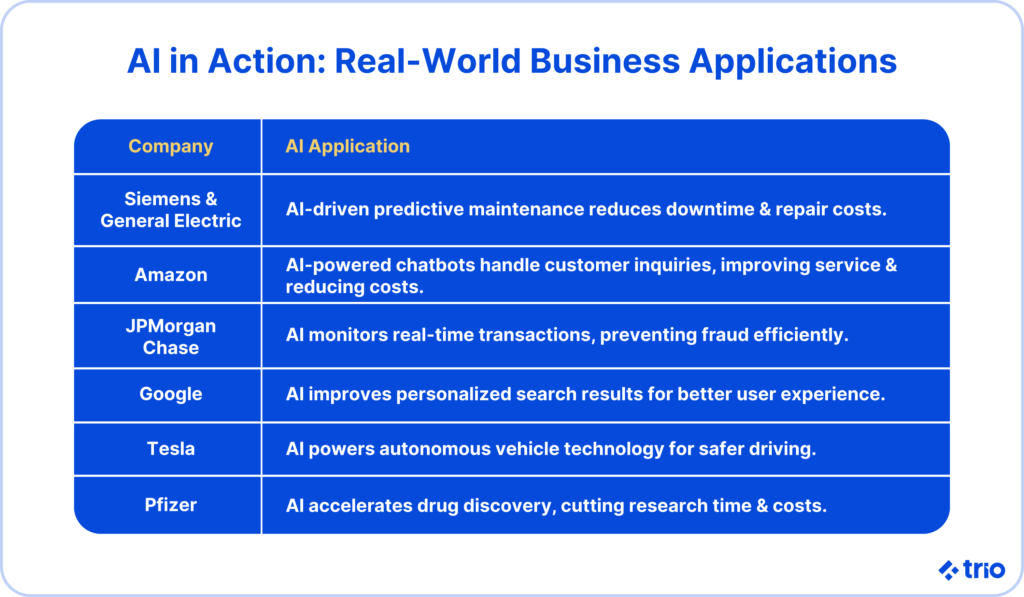Many companies use AI systems to promote business growth through technology. It is becoming a major part of automation and other business processes. With your competitors making use of artificial intelligence integration, failing to do the same means that you are at risk of falling behind.
If you would like to get started with your own AI business integration solutions, you are in the right place. At Trio, we have a variety of skilled people who are familiar with AI technologies. Whether you are in the initial stages of software development or need help with AI implementation and integration with your existing software, we can help through outsourcing or staff augmentation.
But first, let’s take a deeper look at AI models and how these can add to your business value. We’ll also look at the process of integrating AI into business processes so that you can start preparing to use AI tools efficiently in the near future. We’ll also go through some real-world examples of artificial intelligence so you can draw inspiration based on your own business goals.

Understanding AI Integration and Its Importance
Before we can get started, let’s make sure that you understand what AI integration means and the importance of using artificial intelligence in a business setting. Keep in mind that you may not be able to take advantage of all the benefits. However, selecting the right AI tools and systems could be a major game changer.
What is Artificial Intelligence (AI) Integration?
AI integration is the process of embedding AI into your business processes. This can be in the form of machine learning, computer vision, natural language processing, and even generative AI. The idea is to augment human efforts.
Usually, businesses incorporate AI to automate repetitive tasks that take up a lot of time when done manually or where mistakes might cause issues. We’ve also seen many people use AI to analyze data – especially larger sets – and facilitate smarter, more informed, and quicker decision-making.
Key Benefits of AI Integration in Business Operations
There are many ways AI has the potential to improve your business. One of the biggest benefits we help our clients achieve is related to AI automation. When you use AI algorithms to take care of repetitive, mind-numbing tasks, you free up your employees to focus on other things that require a more creative or strategic approach.
And since you aren’t paying AI a monthly salary, this can mean that you improve not only general operational efficiency but also cost-effectiveness, leading to massive savings down the line.
AI-driven data analysis – which we have mentioned above – also provides you with much deeper insights far faster than you would have been able to get even the most basic information otherwise. This helps your decision-makers pick up on trends in real time and helps them react quickly, saving you money by allowing you to optimize processes or even anticipate customer behaviors.
When it comes to information, there is also the potential of AI to be more bias-free, as long as it has been trained correctly. This means you won’t have someone’s ideas or preconceptions influencing the data.
Finally, AI can help your clients feel like they are receiving a personalized experience in many cases. This not only increases client satisfaction and loyalty but also helps you to build a more positive brand image.
How to Integrate AI into Your Business: A Clear Strategy
There are a couple of things you need to take care of to integrate AI capabilities into your business effectively. For all our clients here at Trio, we focus on building a clear strategy. This allows you to prepare for any potential issues, plan to transition the non-tech side of your business, and even see if there are any areas you haven’t considered where you could be using AI to enhance productivity.
Here are some of the key elements of our process, with an experienced automation developer helping the entire way.
Define Your AI Strategy and Business Objectives
Start by clearly defining your strategic objectives. This is where you consider your business as it currently is and how you could benefit the most significantly from the use of AI across your operations.
This could include anything like customer support responsiveness, streamlining supply chain processes, or enhancing internal decision-making. These are just a few examples; the opportunities are endless.
Your focus should be on areas where AI can make the biggest difference for your broader organizational goals to make sure you develop an AI strategy that is as profitable for you as possible. You can always address additional areas of your business later.
Choosing the Right AI Solution for Your Business Process
Now that you know which areas you would like to improve based on your overall business goals, you need to choose the right AI solution. You may require several different options with the new AI capabilities, or there may be none, and you may choose to create a custom solution.
To help you make your decision, consider factors like scalability, compatibility with your current systems, cost-effectiveness, and ease of implementation.

Custom AI Solutions vs. Off-the-Shelf AI Software
Not every solution will be right for everyone. If you have a startup or a small business, you might benefit more from an off-the-shelf solution with easy implementation, even if you don’t end up using all the features.
If you are a large company or enterprise with a bigger budget and many existing systems, a custom-built solution that ensures you can seamlessly integrate AI across all of your entire existing ecosystem of tools may be more profitable in the long run, even though it costs more upfront.
Consider your business size, budget, unique operational requirements, and urgency of implementation to figure out which might be the best option for you.
Step-by-Step Approach to Implement AI Successfully
Now, you should have a good idea of how you plan to transform your business using AI services, and you should have a chosen tool or be in the process of having a custom tool created. The next steps will involve the effective implementation of this chosen AI platform. This, in our opinion, is the most critical and also the most difficult part.
If you need assistance implementing AI to transform your business, our experts can help you do this efficiently, with as little downtime to existing systems as possible.
Preparing Your Business Operations for AI Adoption
There are a couple of things that you can do to prepare your business for AI integration. In your initial analysis, where you identify inefficiencies, redundancies, or tasks suitable for automation, you should also review your data infrastructure.
Consider whether or not the technology you have at the moment is robust enough to support advanced AI capabilities and the enormous processing power that AI requires.
You also need to consider the type of data that you are going to be working with. Although many advanced models and generative AI services are now able to make inferences, this could increase the chances of mistakes. Fixing any issues related to data quality and readiness is important to ensure the success of your AI journey.
Outside of technology, you need to prepare your employees by fostering a positive outlook on AI and a culture of innovation. Make sure that you are educating the affected teams about AI’s potential and how it will support – not replace – their roles. This transparency will reduce employee resistance.
Overcoming Common Challenges When Integrating AI
Even though you do all the preparation, you do not completely minimize the possibility of issues appearing as you start deploying AI across your business operations. Some challenges you may encounter include data security concerns, compatibility issues with legacy systems, skill gaps, and internal resistance to change, which we have already mentioned above.
Trying to deal with these issues proactively is essential. But there are some other strategies you can consider.
Start implementing robust governance policies that work for your business and the new AI systems. Your developers should be able to help you with this if you are creating a custom tool, but if you are purchasing an off-the-shelf solution, ensure that you get one that considers data privacy.
In some cases, existing systems might be very outdated and difficult to work with. In these cases, consider gradually upgrading your legacy systems. You’ll likely need to do this eventually in any case to ensure that you accommodate other modernizations, not just your new AI technologies.
Real-World Examples of AI Integration in Business
It’s always a good idea to keep up with what other people are doing to make sure that you are staying competitive. AI is taking the world by storm, reshaping a variety of industries. Let’s take a look at some of the biggest examples.
Practical Examples of AI Enhancing Business Operations
Many companies are using AI to achieve substantial improvements in their business operations. The most notable example is Siemens General and Electric, which has adopted AI-driven predictive tools in their maintenance scheduling systems. These tools also anticipate failures. The result of these systems has been a decrease in unexpected downtime and repair costs.
Amazon is also using AI in business operations. The tech giant is using AI chatbots to handle customer inquiries. This helps reduce the number of employees they need in this area of customer service while simultaneously improving customer satisfaction by giving them immediate answers to many of their questions.
Many financial services industries are also using fraud detection systems powered by AI algorithms. JPMorgan Chase is a notable example that uses these monitoring systems to analyze the millions of transactions conducted by their clients in real time, picking up on issues almost instantly.
Companies Successfully Implementing AI Initiatives
Outside of enhancing business operations, there are many other ways that companies are successfully implementing AI initiatives. Google is utilizing AI in its search algorithms to improve personalized results, while Tesla uses AI in its autonomous vehicle technology. Neither of these are internal business operations per se but instead part of their product offerings to improve user experience.
Pfizer is also using AI in drug discovery to accelerate the process and cut associated research costs. This is important to note as AI helps businesses in a variety of fields rather than just those in the tech or SaaS industries.

Measuring Success: How to Know Your AI Integration Works
It is important that you understand how to measure the success of your AI integration. So, what are some of the things you should be looking out for?
Key Metrics to Evaluate AI Integration Success
Fewer errors and higher productivity are good indicators to look at in terms of business operations improvements. Another popular way to determine if your AI integration is successful is to track tangible financial impacts like return on investment (ROI), cost savings, and revenue growth in the affected fields.
For more client-facing implementations, customer engagement and satisfaction also serve as critical metrics. By monitoring customer satisfaction ratings, retention rates, and engagement levels, businesses can quantify AI’s impact on enhancing customer experiences.
Continuous Improvement of Your AI Integration Strategy
Like many other tech features, AI requires constant improvement in order to keep working well and to stay up to date with the latest trends. A good way to make sure that your systems are still working well is to review your metrics regularly. This will not only allow you to figure out that there is an issue but also give you an indication of where it may be.
It’s also important that you keep an eye on what everyone else is doing and experiment with the latest trends to see if you can promote any improvements.
One of the best ways you can ensure that your AI tools are integrated well and that your systems are maintained going forward is to work with a long-term tech partner.
Here at Trio, we don’t just get the job done and then leave you to figure things out. Instead, we will make sure that you have continued access to developers to help you with any issues that may arise. In many cases, we are able to provide the same developers who helped with the initial development and integration and who are already familiar with your systems.
After all, your success is our success.
For more information and to get started, reach out to schedule a free consultation!






